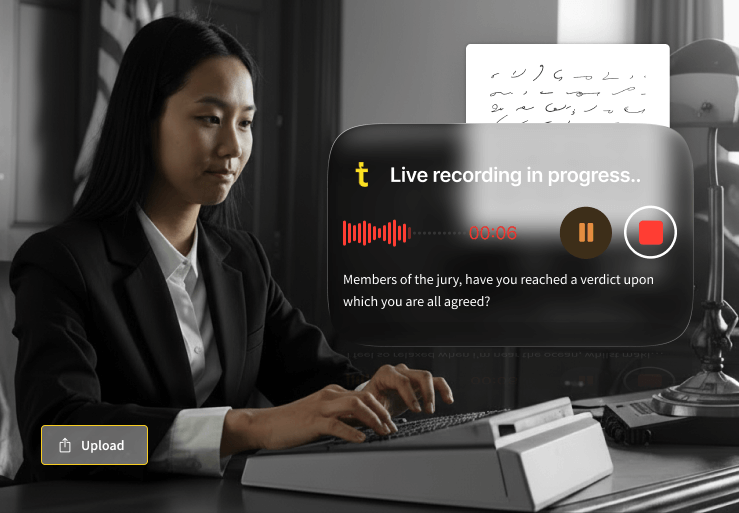Law runs on language. Every week, attorneys and legal teams handle hours of spoken content — from depositions and court hearings to strategy meetings and dictated correspondence. And turning those recordings into clear, accurate text is a crucial step for building airtight contracts, persuasive arguments and winning cases.
This is where legal transcription comes in. But what exactly does it involve, who does the work and how are innovations like AI transcription software changing the status quo?
What is legal transcription? With examples
Legal transcription is the process of turning audio or video recordings into written documents. While most people associate it with court transcripts — typically handled by certified court reporters or stenographers using specialized tools — it extends far beyond the courtroom. Transcription is a core part of legal practice, supporting everything from case prep to client communication.
Law firms regularly need to transcribe a wide range of recorded content, including:
- Depositions
- Witness statements
- Client interviews and calls
- Internal meetings and briefings
- Dictation for correspondence like letters, memos or emails
- Digital evidence from online activity to screen recordings
- Legal research or strategy sessions
In short: if your team records it, there's a good chance you’ll need it transcribed.
What does a legal transcriptionist do?
A legal transcriptionist converts audio or video recordings into clear, accurate written documents. They may work in-house at a law firm or be hired through a freelance arrangement or specialized transcription agency.
The job demands fast, precise typing, a solid understanding of legal terminology and strong attention to detail. Fluency in the language(s) spoken in the recording is essential, especially when clarity and nuance matter. Because the content is often highly sensitive, transcriptionists typically operate within strict security frameworks to protect client confidentiality.
Still, even the most skilled professionals can’t escape the realities of manual transcription: it’s time-consuming, resource-heavy and often too slow for fast-moving legal teams.
How does manual legal transcription work?
With manual transcription, the transcriber listens closely to the audio or video file and types out every word they hear. They might clean up the text as they type by skipping filler sounds like "um" or coughing to make the doc easier to edit. Or, depending on the requirements of the job, they may go full verbatim — capturing every pause, slip of the tongue and sigh. To speed things up, legal transcriptionists often use assistive tools like foot pedals to control playback without interrupting the flow of typing.
In many law firms, transcription falls to legal assistants, PAs or secretaries. When transcription workloads pile up, firms often turn to third-party specialists to clear the backlog. Either approach costs time and money. But with the latest advances in AI, that’s starting to change.

Why efficient transcription matters
Accurate, reliable transcripts are foundational to the overall workflows within a law firm. They support better decision-making, create a paper trail for compliance purposes and reduce risk by ensuring no detail is missed.
Manual transcription has been the default for decades, but it leaves a lot to be desired. Many firms still grapple with inefficiencies, delays and rising costs. Key challenges include:
- Time pressure: It can take four hours or more to transcribe just one hour of audio (GMR) — and that's for a skilled transcriptionist. Multiply that across a case and delays quickly stack up.
- Accuracy: One error can change the meaning of a statement or undermine an entire argument. The risk of human error can never be completely eliminated, even with the most skilled transcriptionists.
- Confidentiality and security: Outsourcing transcription to a freelancer or agency introduces security and privacy vulnerabilities — unacceptable in a profession where client confidentiality is everything.
- High overheads: Manual transcription services can charge upwards of £9,000 ($12,000) for 100 hours of transcription (Trint). And that’s before you factor in urgent turnarounds or complex audio. This increases overheads and eats into profit margins.
- Manpower: Manual transcription ties up legal staff in low-value tasks, taking time away from more productive billable work.
The future: manual vs automated legal transcription
Without the right systems in place, manual transcription becomes a drain on your team’s time, budget and focus. But there is an alternative: AI-powered transcription.
AI used to have a bad rep in legal circles, with legal professionals citing concerns about security and sloppy, inaccurate transcripts. But today, tools like Trint are rewriting the rulebook and law firms are embracing AI.
Trint’s advanced speech recognition and machine learning deliver fast, precise transcripts in minutes — not days — and at a fraction of the cost. Unlike free built-in AI tools, Trint locks down your data with watertight security, helping your firm stay fully compliant with regulations.
The bottom line? Adopting a trusted, enterprise-grade AI transcription platform like Trint is one of the smartest moves to boost efficiency in a modern law firm.
So, why should legal firms consider making the switch? Let's break it down.
*Manual cost: £1.50/minute or £90/hour - https://www.typeout.co.uk/about/how-much-do-we-charge/. Trint cost: £48 per month of Advanced plan access.
**Manually transcribing 1 hour of audio = 4 hours work for skilled transcriptionist (https://www.gmrtranscription.com/blog/transcribing-an-hour-of-audio). Trint can transcribe audio files up to 3 hours long in just a few minutes.
AI is already transforming how law firms manage their transcription workflows. And with Trint, legal professionals can spend less time on tedious typing and more time practicing law. But don't just take our word for it: book a demo and get a free trial to see what Trint could do for your firm today.











